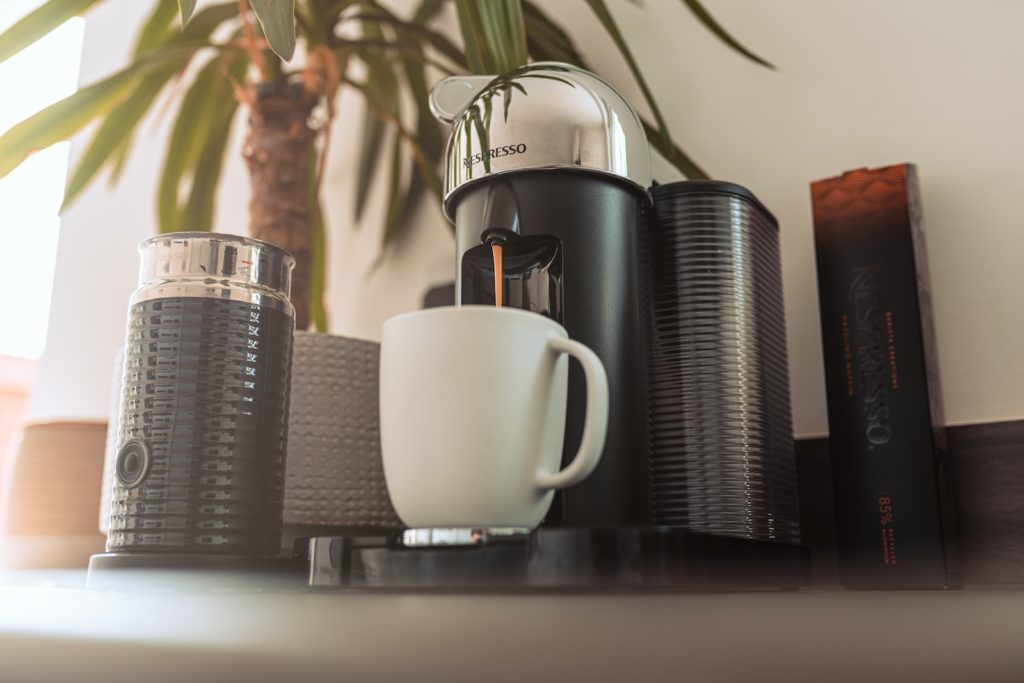
In the world of Nespresso pods, two brands stand out for popularizing coffee pods: Keurig and Nespresso. While Keurig initially had a head start in North America, Nespresso quietly led the way in Europe, setting the stage for its eventual domination in the market. In this article, we’ll delve into the story of how Nespresso became a coffee pod craze and how it embraced sustainability to stay ahead of the competition. We’ll explore the ingenious marketing tactics, the influence of its parent company Nestle, and the quest for eco-friendly solutions. So grab your favorite cup of coffee, and let’s spill the beans on Nespresso!
Nespresso’s Early Days: The European Origin
In 1975, a brilliant engineer named Eric Favre conceived the idea of a machine that would allow people to make sophisticated espresso at home, replacing the need to visit espresso bars. His patented technology, utilizing high pressure to create the signature foam topping of high-end espresso, became the foundation of Nespresso. Initially, Nespresso machines found their way into offices, but it was Jean-Paul Gallaud, the CEO in 1990, who transformed Nespresso into a luxury at-home brand. By creating an exclusive club, lowering machine prices, and raising the cost of their single-use capsules, Nespresso gained traction in Europe’s upper-class homes.
Conquering North America
However, breaking into the North American market proved challenging. The preference for larger, quickly brewed coffees in oversized styrofoam cups didn’t align with Nespresso’s elegant espresso offerings. So, in 2014, Nespresso launched new machines capable of making larger European-style cups, blending convenience and sophistication. But that wasn’t enough; they needed something special to win over American consumers. Enter the charismatic George Clooney, who became the face of Nespresso in North American ads, boosting their appeal.
Sustainability Push
Besides superior marketing, Nespresso set its sights on sustainability, recognizing the environmental concerns surrounding coffee pods. While Keurig faced criticism for its non-recyclable K-Cups, Nespresso took a different approach. They made substantial sustainability promises, vowing to protect the rainforests, support small coffee farmers worldwide, and replace disposable pods with recyclable aluminum capsules. The company even offered a program to recycle used pods through Nespresso boutiques or mail-in options.
The Reality of Recycling
Despite their bold claims, Nespresso’s recycling program faced challenges. Experts estimate that only about 5% of the 14 billion sold pods annually are actually recycled. Many end up in landfills or suffer from mold growth when left in the recycling bag for extended periods. Nespresso’s marketing, inspired by parent company Nestle, focuses on promoting recycling without a concrete way to track actual recycling rates. Nevertheless, Nespresso’s efforts earned it the title of the most sustainable coffee company by a finance magazine, further solidifying its appeal.
Seeking Alternatives: Compostable and Reusable Pods
In response to the coffee pod waste issue, other companies introduced compostable pods to the market. However, these pods face manufacturing difficulties, and the challenge of proper disposal remains. Many waste management companies don’t accept them in compost collections due to confusion with plastic pods.
Embracing the Reusable Solution
Reusable coffee pods emerged as an alternative to single-use pods, promising cost-saving benefits and reduced waste. Yet, they come with their own challenges. Users must find the right pod to fit their machine and get the grind and measurements precisely correct to avoid a subpar coffee experience.

Conclusion
Nespresso’s journey from an exclusive European brand to a global coffee pod phenomenon is a testament to effective marketing and strategic moves. While their sustainability initiatives face some obstacles, Nespresso remains a strong contender in the coffee industry. As consumers, we must recognize the importance of making eco-conscious choices and consider the true impact of our coffee habits. Whether you opt for Nespresso or explore compostable and reusable options, every small step towards sustainability counts. So, as you sip your next cup of coffee, remember that you hold the power to make a difference, one coffee pod at a time.
Key Takeaways
- Nespresso emerged as a coffee pod trendsetter in Europe with its sophisticated espresso machines, later conquering the North American market with larger coffee options and George Clooney as their brand ambassador.
- Nespresso’s commitment to sustainability, including recyclable aluminum capsules, garnered praise, but their actual recycling rates remain low, leading to environmental concerns.
- Compostable coffee pods offered an eco-friendly alternative, but challenges in manufacturing and disposal hindered widespread adoption.
- Reusable coffee pods offered cost-saving benefits, but perfecting the coffee-making process with them can be tricky for users. Ultimately, consumers play a significant role in making sustainable coffee choices.
